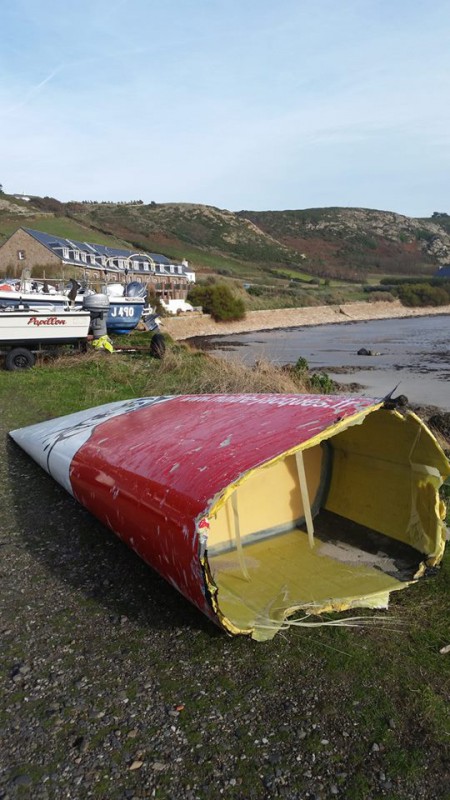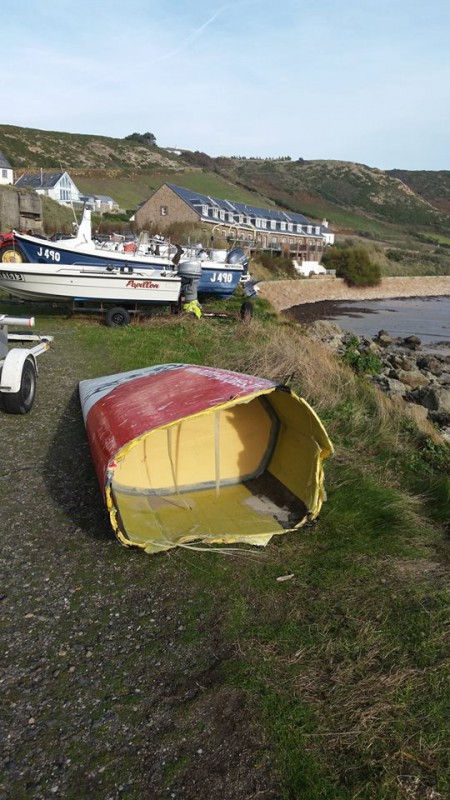This prime example of stuff done wrong was sitting right in front of me for a few days before I grasped the teachable moment in it. And it is another example of what I have often seen where it is asserted “it must be right because they are famous.” In today’s chapter, first the boat. The bow broke off of this 50′ (I assume) trimaran in the Route de Rhum. I have not seen the actual wreckage nor spoken to anyone who has. But it seems like a lot can be understood by looking at these pictures.
Two things jump out immediately. First, that sure looks like Kevlar, and second, the core looks thin. It could be 19mm but it sure looks more like 12mm. And the damage is quite clean, not ragged.
First, Kevlar? Really? In my opinion Kevlars’ only use is as a yuppie magnet. Not only does it not actually stick to the resin matrix, but its compression strength is about 1/3 its tensile strength. And it’s tensile strength is still 20% less than that of lowly E-glass.
Now notice at the 3 corners of the hull section are tiny carbon fiber stacks. That is bad practice on at least two counts. First, the carbon has less than half the stretch to failure of Kevlar, so the carbon must fully fail before the Kevlar’s tepid strength is even at 50%. Next, if it is a carbon stack as it looks, with the differing stretch, it could pop off the Kevlar with a shear failure.
The clean break feels more like a tensile failure instead of buckling at first glance. I see a scenario where there was a partial buckling failure which popped the resin matrix off of the Kevlar in a circumference line. Later that weakened fabric is hit from the opposite direction and fails cleanly.
Why didn’t they know all this? I can think of an elderly designer or two who would not know this kind of thing, but it has been out there for a long time. Next, the Multi 50 rule is just as bad.


Interestingly Shuttleworth recently posted on Steam radio re. Kevlar as follows:
“We put Kevlar inside. It is partly because it is significantly better in tension than compression, but also when water penetrates the resin fibre matrix it acts like a wick and the water will migrate into the laminate – not something you want in a material that is very close to the water all the time. Small areas of damage that are not attended to can make this a problem. The third reason is that in an impact the outer skin will rupture – the foam will distort It is is either Airex R63.80 or Corecell A500 and the inside skin will stay intact even if the resin starts to fracture. The idea is that the foam and outer skin absorb a lot of the energy before it gets to the inner skin – which is ultra strong in tension. this combination has proved very successful in a number of cases of grounding or high impact on the hull.
Kevlar does need to be laid in a combination with glass, because the resin does not stick to the fibres very well. For the bigger boats we use a unidirectional fabric with alternate tows of kevlar and glass 50:50 by volume. This means that each layer is 660 gms/m2 Aramid/Glass – 237 gms/m2 Aramid, 422 Glass Unidirectional.”
Regards
John Shuttleworth
for Shuttleworth Design Ltd.
I saw that. Amazing. So many things wrong as I see it. Those all seemed like reasons to never use Kevlar. A grounding or impact is usually bow or keel line. I cannot see tension strength helping against basically shear load.
The multihull will not sink so holing is not the worst of worlds. The disadvantage of tensile strength across in interior panel is that a small impact can make a huge delamination inside. Especially since the Kevlar is not bonding to anything else.
The Kevlar in combination with glass seemed to be a bad solution for a couple of reasons. Even if the glass is a good laminate, the poorly bonded Kevlar between glass lams means very poor shear transfer between layers. So why bother with the Kevlar at all?
Finally if the Kevlar is for impact, a woven fabric is much better than a uni or a knitted fabric.
I would never recommend Kevlar as noted above.
What Kurt says is correct. The designer and especially the builder should have caught the mistake. Probably some sandwich core structural software would have caught it too.
This type of racers have beacons, teams of people behind them, deep pockets etc plus they are experienced. It is rare that injuries and death plaque them.
This is no fishing boat or cruiser having to wait for a second EPIRB doppler shift (4-6 hours) to get a contact hail if anybody is available.
Remember crawling through the hulls of the Enza catamaran when she was in Seattle? And commenting on the hard 90 degree bulkhead attachment? As I recall that boat was drastically lengthened and the mast radically raked to compensate.
Altho being lucky is always better than being right— in that case lucky enough to be the first boat to circumnavigate in under 80 days.
Cheers,
Richard
This time it’s the new floats that were fitted after the TJV break the old floats were discarded as too fatigued to repair. The new floats were built in the same float molds as the ones on the Multi50 FenetreA Cardinal.
This is the starboard float off Maitre Jacques, which was a repair job after it broke off in the TJV. The repair probably has something to do with the clean break!